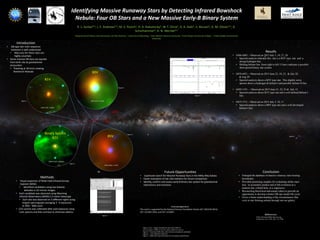
AAS PPP 2.0
- 1. Identifying Massive Runaway Stars by Detecting Infrared Bowshock Nebula: Four OB Stars and a New Massive Early-B Binary System R. L. Sorber4,2, J. E. Andrews1,2, M. S. Povich1, H. A. Kobulnicky2, W. T. Chick2, D. A. Dale2, S. Munari2, G. M. Olivier3,2, D. Schurhammer2, H. N. Wernke5,2 1Department of Physics and Astronomy, Cal Poly Pomona, 2 University of Wyoming, 3 Case Western Reserve University, 4 Front Range Community College, 5 Embry-Riddle Aeronautical University B1V G092.3191 + 0.0591 Binary System B2V G086.55104 -1.083935 G075.5711 -0.2558 B0V G076.69921 -2.4071 B5V Introduction • OB type star main sequence evolution is well understood • Mass loss for these stars are highly uncertain • Some massive OB stars are ejected from birth site by gravitational encounters • Traveling at 30 km/s creating Bowshock Nebulae Methods • Visual inspection of Wide Field Infrared Survey Explorer (WISE) • Identified candidates using low Galactic latitudes in 22-micron images. • Each candidate was observed using Wyoming Infrared Observatory (WIRO) 2.3 meter telescope. • Each star was observed on 3 different nights using longslit spectrograph averaging 3 - 6 exposures at 300s - 600s each. • CCD camera was calibrated after eachexposure using CuAr spectra and flats and bias to eliminate defects. Results • G086.6083 – Observed on 2015 July 3, 10, 27, 28 • Spectral analysis indicates this star is a B2V type star and a strong hydrogen line. • Shifting helium line from right to left 15 km/s indicates a possible short-period binary star system. • G076.6921 – Observed on 2015 June 23, 10, 23, & July 28, & Aug 29. • Spectral analysis shows a B5V type star. This slightly noisy spectra shows a hydrogen & helium I and possibly helium II line. • G092.3191 – Observed on 2015 June 21, 22, 23 & July 12 • Spectral analysis shows B1V type star and a well defined helium I line. • G075.5711 – Observed on 2015 July 3, 10, 11 • Spectral analysis shows a B0V type star and a well developed helium I line. Conclusion • Enlarged the database of massive runaway stars hosting bowshocks. • Provided promising samples for evaluating stellar mass loss to accurately predict end of life evolution as a neutron star, a black hole, or a supernova. • Reconciling theoretical and actual values to provide an opportunity to develop a better OB star model life cycle. • Gives a better understanding of the circumstances that exist in star forming nebula through out our galaxy. Future Opportunities • Continued search for Massive Runaway Stars in the Milky Way Galaxy • Closer evaluation of star vital statistics for future comparison • Identify, confirm and assess early-B binary star system for gravitational interactions and evolution. Acknowledgements This work is supported by the National Science Foundation Grants AST-1063146 (REU), AST-1411851 (RUI), and AST-1412845. References: Photo: Panorama Milky Way, eso.org Kobulnicky et al., 2010. ApJ, 710, 549K Figure 1,2,3,4 - images of bowshock stars red is WISE 22 microns, green is WISE 12 microns, blue is WISE 3.4 microns Figure 5 – Panorama Milky Way with red dots as bowshock candidates Figure 6 - CuAr calibration spectrum Figure 7 – G092.3191 spectral analysis for star typing using SPTassist Figure 6 Figure 7 Figure 5 Figure 4 Figure 3 Figure 2 Figure 1